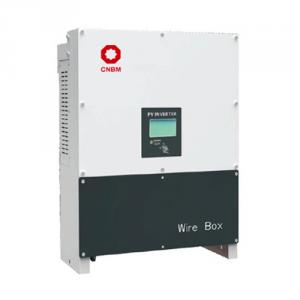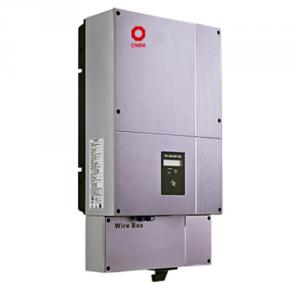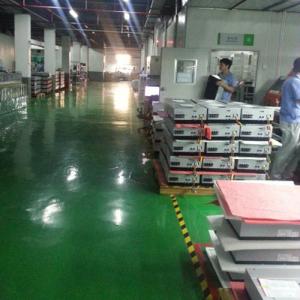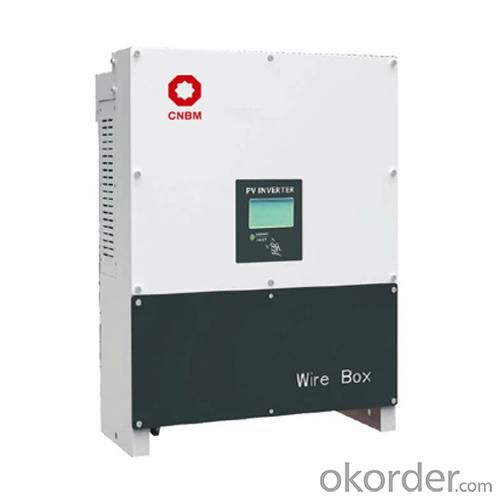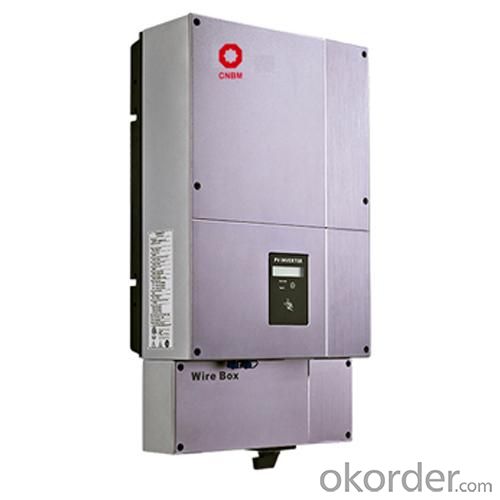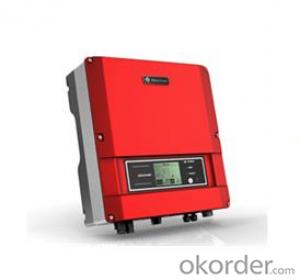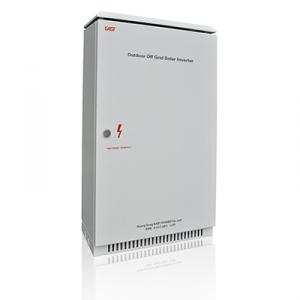Ta Solar Inverter 3-Phase Grid Tied 10000W
- Loading Port:
- Shenzhen
- Payment Terms:
- TT or LC
- Min Order Qty:
- 1 unit pc
- Supply Capability:
- 5000Units/Per month pc/month
OKorder Service Pledge
OKorder Financial Service
You Might Also Like
Grid Tied Solar Inverter 3-phase 10000W
CNBM International Corporation (CNBM International) is the most important trading platform of CNBM Group Corporation, a state-owned company under the direct supervision of State-owned Assets Supervision and Administration Commission of the State Council.
With a R&D team more than 100 engineers,40% of the staff, who has been deeply engaged in the photovoltaic industry for 10 years, CNBM takes the mission to increase the inverter availability and efficiency, putting continuous innovation to make CNBM inverter easier for installation and operation, and more cost-effective for solar plant construction. The full range of CNBM single phase inverters has received VDE, CE, G83/1, G59/2, ENEL2010, VDE4105, C10/C11, AS4777 etc.
Maximum efficiency of 97.8% and wide input voltage range, Internal DCswitch,MTL-String, Sound control,Bluetooth/RF technology /WiFiTransformerless,GT topology
The Grid Connected Solar Inverter we can offer is 1.5kw to 20kw.
Introduction of Grid Tied Solar Inverter 3-phase 10000W
Maximum efficiency of 97.8% and wide input voltage range
Integrated DC switch-disconnected
MTL-String
Sound control
Bluetooth/RF technology /Wi-Fi
Transformerless GT topology
5 years warranty (10 years as optional)
Datasheet of Grid Tied Solar Inverter 3-phase 10000W
Model | 10000TL3-US | 12000TL3-US | 18000TL3-US | 20000TL3-US |
Input data(DC) | ||||
Max. DC Power | 10500W | 12500W | 18750W | 20850W |
Max. DC voltage | 600V | 600V | 600V | 600V |
Start voltage | 120V | 120V | 120V | 120V |
PV voltage range | 80V-600V | 80V-600V | 80V-600V | 80V-600V |
Max. input current of the MPP tracker A/tracker B | 21A/21A | 25A/25A | 38A/38A | 42A/42A |
Number of MPP trackers/strings per MPP tracker | 2/3 | 2/3 | 2/6 | 2/6 |
Output data(AC) | ||||
Nominal output power | 10000W | 12000W | 18000W | 20000W |
Nominal AC voltage | 480V | 480V | 480V | 480V |
AC voltage range | 422-528VAC | 422-528VAC | 422-528VAC | 422-528VAC |
Nominal AC grid frequency | 60 Hz | 60 Hz | 60 Hz | 60 Hz |
Max. output current(cos φ=1) | 12.0A | 14.5A | 21.5A | 24A |
Power factor(cos φ) | >0.99 | >0.99 | >0.99 | >0.99 |
Harmonics | <3% | <3% | <3% | <3% |
Grid connection type | 3/N/E | 3/N/E | 3/N/E | 3/N/E |
Efficiency | ||||
Max. efficiency | 97% | 97% | 97.5% | 97.5% |
CEC-Weighted efficiency | 95.5% | 95.5% | 96% | 96.5% |
MPPT efficiency | 99.5% | 99.5% | 99.5% | 99.5% |
Protection devices | ||||
Input over voltage protection -DIN rail surge arrester(Option) | Class II | Class II | Class II | Class II |
DC insulation measure | yes | yes | yes | yes |
AC short circuit protection | yes | yes | yes | yes |
Output over voltage protection -Varistor | yes | yes | yes | yes |
Output over voltage protection -DIN rail surge arrester(Option) | Class II | Class II | Class II | Class II |
String fuse type/size(Option) | 15A/600VDC 10*38mm | 15A/600VDC 10*38mm | 15A/600VDC 10*38mm | 15A/600VDC 10*38mm |
General Data | ||||
Dimensions(W*H*D) in mm | 530*705*247 | 530*705*247 | 650*740*247 | 650*740*247 |
Weight | 46kg/101.5lb | 46kg/101.5lb | 63kg/138.9lb | 63kg/138.9lb |
Operating ambient temperature range | –25°C ... +60°C | –25°C ... +60°C | –25°C ... +60°C | –25°C ... +60°C |
Altitude | ≤2000m/6560ft | |||
Self Consumption night | < 3 W | < 3 W | < 3 W | < 3 W |
Topology | Transformerless | |||
Cooling concept | Fan Cool | Fan Cool | Fan Cool | Fan Cool |
Electronics protection rating /connection area | NEMA 3R | NEMA 3R | NEMA 3R | NEMA 3R |
Features | ||||
Display | Graphic | Graphic | Graphic | Graphic |
Interface:RS232/RS485/ Bluetooth/RF/Zigbee/Wifi | yes/yes/opt/opt /opt/opt | |||
Warranty:10 years /15 years | yes/opt | yes/opt | yes/opt | yes/opt |
Certificates and approvals | UL1741,UL1998,IEEE1547,FCC part 15(class B),CSA C22.2 No.107.1 | |||
Picure1: Factory of Grid Tied Solar Inverter 3-phase 10000W
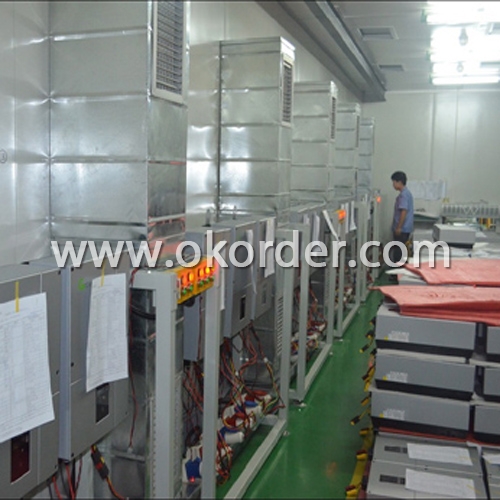
Picture 2: Package of Grid Tied Solar Inverter 3-phase 10000W
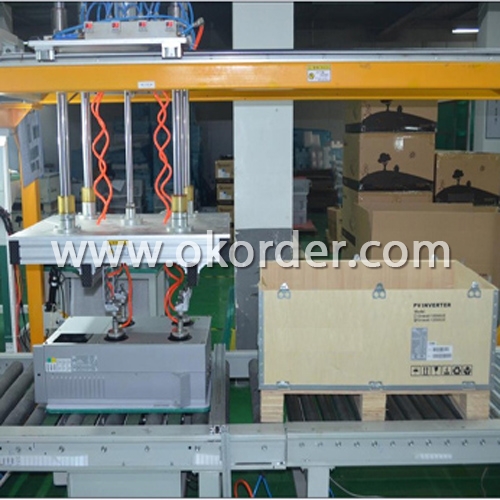
- Q: How does a solar inverter handle variations in solar irradiation?
- A solar inverter handles variations in solar irradiation by continuously monitoring the amount of sunlight received and adjusting the conversion of direct current (DC) power generated by the solar panels into alternating current (AC) power accordingly. It does this by employing maximum power point tracking (MPPT) algorithms that optimize the power output from the panels, ensuring maximum efficiency regardless of the fluctuations in solar irradiation.
- Q: How does a solar inverter handle variations in solar panel cleanliness?
- A solar inverter does not directly handle variations in solar panel cleanliness. However, a decrease in solar panel cleanliness can lead to a decrease in the overall energy output of the solar system. This reduced energy input is then processed by the solar inverter, which converts it into usable electricity. Therefore, while a solar inverter itself does not handle the cleanliness of solar panels, it indirectly adapts to variations by adjusting the energy conversion process based on the input it receives from the panels.
- Q: How does a solar inverter handle sudden changes in solar irradiation?
- A solar inverter handles sudden changes in solar irradiation by constantly monitoring the incoming solar energy and adjusting its output power accordingly. When there is a sudden increase in solar irradiation, the inverter increases its power output to match the higher energy generation. Similarly, when there is a sudden decrease in solar irradiation, the inverter reduces its power output to align with the lower energy production. This dynamic response ensures the inverter efficiently converts the available solar energy into usable electricity, regardless of variations in solar irradiation.
- Q: Can a solar inverter be used with a solar-powered disaster relief system?
- Yes, a solar inverter can be used with a solar-powered disaster relief system. A solar inverter is an essential component of a solar power system, converting the direct current (DC) generated by solar panels into alternating current (AC) that can be used to power electrical devices. In a disaster relief system, solar panels capture sunlight and convert it into electricity, which is then fed into the inverter to produce usable AC power for various relief operations such as lighting, charging devices, or running essential equipment. Thus, a solar inverter is crucial in enabling the functionality and effectiveness of a solar-powered disaster relief system.
- Q: What is the maximum number of solar panels that a solar inverter can support?
- The maximum number of solar panels that a solar inverter can support depends on the specific model and its capacity. However, most solar inverters are designed to support a certain capacity or power rating, rather than a specific number of panels. The capacity of the solar inverter, measured in kilowatts (kW) or megawatts (MW), determines the maximum power output it can handle. The number of panels that can be connected to the inverter depends on the power rating of each panel. So, it is best to consult the manufacturer's specifications or seek professional advice to determine the maximum number of panels that can be supported by a specific solar inverter.
- Q: How does a solar inverter interact with the electrical grid?
- A solar inverter interacts with the electrical grid by converting the direct current (DC) electricity generated by solar panels into alternating current (AC) electricity that is compatible with the grid. It synchronizes the generated electricity with the grid's voltage and frequency, allowing excess power to be fed back into the grid for others to use, and drawing additional power from the grid when needed. This interaction ensures efficient utilization of solar energy and seamless integration of solar power into the existing electrical grid infrastructure.
- Q: Can a solar inverter be used with different types of power conditioning units?
- No, a solar inverter is specifically designed to work with solar power conditioning units. It may not be compatible with other types of power conditioning units such as wind or hydro power systems.
- Q: Can a solar inverter be used with different types of energy storage systems?
- Yes, a solar inverter can be used with different types of energy storage systems. Solar inverters are typically designed to convert the direct current (DC) generated by solar panels into alternating current (AC) that can be used to power household appliances and other electrical devices. They can be integrated with various energy storage technologies such as batteries, supercapacitors, and flywheels to store excess energy generated by the solar panels for later use. The compatibility between the solar inverter and the energy storage system may depend on factors such as voltage requirements, capacity, and communication protocols.
- Q: Can a solar inverter be used in a smart grid system?
- Yes, a solar inverter can be used in a smart grid system. A solar inverter is responsible for converting the direct current (DC) generated by solar panels into alternating current (AC) that can be used to power homes and businesses. In a smart grid system, the solar inverter can play a crucial role in integrating solar energy into the grid, enabling bi-directional energy flow, and facilitating real-time communication and control between the solar system, grid operators, and consumers. This allows for efficient energy management, improved grid stability, and optimization of renewable energy utilization within the smart grid network.
- Q: How does a solar inverter affect the value of a property?
- A solar inverter can positively impact the value of a property by enhancing its energy efficiency and reducing electricity costs. This renewable energy technology is attractive to potential buyers as it provides clean and sustainable power generation. Additionally, having a solar inverter installed can increase the overall appeal and marketability of a property, making it more desirable in today's environmentally conscious market.
Send your message to us
Ta Solar Inverter 3-Phase Grid Tied 10000W
- Loading Port:
- Shenzhen
- Payment Terms:
- TT or LC
- Min Order Qty:
- 1 unit pc
- Supply Capability:
- 5000Units/Per month pc/month
OKorder Service Pledge
OKorder Financial Service
Similar products
Hot products
Hot Searches
Related keywords
